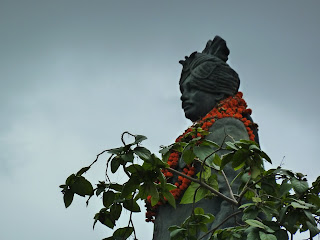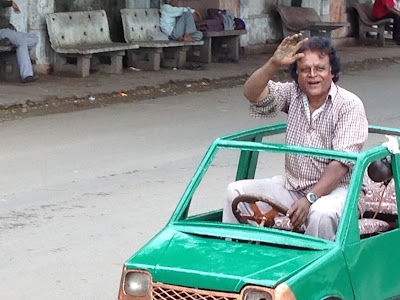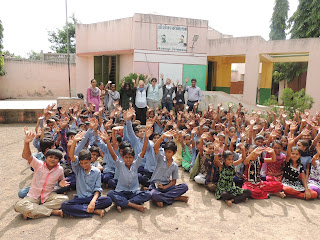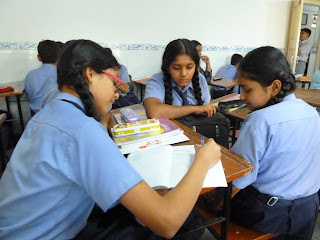What a week and it has literally flown by.
We were able to complete our final report and presented our
findings to the Essar Foundation on Wednesday and Thursday. For those of you
interested, I have included a high level summary of our report in the below –
for the rest of you; simply jump to the next section :-)
 Despite the implementation of the
Right to Education Act and significant Government investments in primary
education, around 44 million Indian children do not go to school, and many who
are starting school, drop out at an early age. Essar Foundation has
particularly taken note of the poor quality of teaching and learning of
English. English is becoming necessary for participation in the digitized world
and good employment. The lack in English education puts the government
school-educated students at a double disadvantage.
Despite the implementation of the
Right to Education Act and significant Government investments in primary
education, around 44 million Indian children do not go to school, and many who
are starting school, drop out at an early age. Essar Foundation has
particularly taken note of the poor quality of teaching and learning of
English. English is becoming necessary for participation in the digitized world
and good employment. The lack in English education puts the government
school-educated students at a double disadvantage.
To start
addressing this, a project between the Essar Foundation and the IBM Corporate
Services Corps was initiated to develop recommendations on how to improve the
quality of English education in the government schools. The primary objective is
to improve the English language capability levels of students in 17 government schools surrounding
the Essar Refinery in Vadinar within the next 2 years. Also, four secondary
objectives in support of the primary objective were defined, i.e. those
specifically focused on Manpower (the resources involved in the education
process), Platform (the learning infrastructure), Methods and Tools (the
interventions used to address the primary objective) and External Stakeholders.
 Working
with the Essar Foundation we visited each government school in the vicinity of
the Vadinar refinery, spending time with the principal, teachers and the
students. In addition, further stakeholders (such as government
representatives, private school teachers and other experts) were interviewed.
The data collected was then analysed to provide short, medium, and long-term
recommendations for improving English language capability.
Working
with the Essar Foundation we visited each government school in the vicinity of
the Vadinar refinery, spending time with the principal, teachers and the
students. In addition, further stakeholders (such as government
representatives, private school teachers and other experts) were interviewed.
The data collected was then analysed to provide short, medium, and long-term
recommendations for improving English language capability.
We had
initially envisaged differentiating the schools based on the students’ and
teachers’ grasp of English and wanted to develop different programs depending
on the school’s level of English. While English capability does vary slightly
across the 17 schools, it is generally very poor though. There are however
significant differences in the schools’ learning environments (for example, the
approach and attitude towards learning, the receptiveness for change and
openness to new ideas) and their appetite to get involved in a program to
improve English language capability. Based on these observations, the schools
were therefore clustered as follows:
*
A cluster: Five schools
that stand out in terms of their achievements to date and/or positive attitude
towards the programme in particular and improving the quality of education
general. This can for example be evidenced by the use of positive
reinforcement, having very capable and motivated English teachers, and/or
having already implemented innovative ways to teaching.
*
B Cluster: Six schools
which are open and interested to improve English language capability and have
the fundamentals in place to get involved in the program (but did not stand out
in a particular way, either in terms of the quality of their education or their
passion for improving this) are grouped in the B-cluster. These schools will
typically have expressed a general interest in getting involved in programs
with the Foundation and will be equipped with the essentials to run the school.
*
C Cluster: Seven schools in
which a reluctance to engage in the program and/or lack the fundamentals to
provide education was observed, were grouped in the C cluster. .
To derive recommendations “fit
for purpose”, a SWOT analysis was conducted, revealing a number of more general
issues with the learning environment that prevents learning from occurring –
irrespective of the subject that is being taught. These need to be addressed in
conjunction with the recommendations of our study as to not derail this effort.
All of the 40+ recommendations
specific to improving English capability were mapped to the objectives and
program categories, i.e.:
* Providing more English learning
interventions to the students with/without a dependency on the
teacher/principal,
* Up-skilling the language teachers,
*
Introducing activity-based
learning and earlier exposure to English within the school’s infrastructure as
a complement to the existing curricula
* Reward, recognition and positive
re-enforcement
* Improvements to the IT
infrastructure
* Leveraging Essar volunteers, and
* Programme management
Due to the different environments
at each school, a one-size-fits-all program of activities is likely to fail.
Instead, a catalogue of options, ideas and recommendations is available which needs to be tailored for
each participating school:
|
Objective
|
Must have
|
Must have
one-of’s
|
Optionals
|
|
Primary
|
- New Hire
- Program Logo and Motto
- Advisory Board
|
- Projects
- English Olympics
|
|
|
Manpower
|
- Teacher Forums
- Mentoring
|
External Volunteers:
- Gap year students
- Teaching students
- English teachers
|
- Field trips
- Adopt a school
- Adopt a student
- English Club
- Conversation Clubs
|
|
Platform
|
- English posters
- Bal Vividha
- IT Infrastructure
|
|
- Computer access
- English murals
- Schools connect (VC)
- Viral books
|
|
Methods & Tools
|
-
Storytelling
-
Task-based learning
-
Teaching Aides
|
-
Monetary Incentives
- Non-monetary Incentives
- Teacher incentives
|
- English learning software
- Motivational videos
- Movie night
- Online books
- Puppeteering
- Debate clubs
- Schools connect (pen pals)
- Teacher newspaper share
|
|
-
Games playbook
-
Quizzes
-
Songbook
|
A roadmap for implementing the
recommendations has been provided and the first step will be to test the
programme with two pilot schools in the villages of Timdi and Vadinar.
The presentation went well (and one of the fun bits was that
we actually included a quick “energiser” and taught our audience the “heads shoulders knees and toes” song which everyone loved :-) and we got really good
feedback on our report.
One of the best bits of feedback is that the Essar
Foundation has started to recruit a new member of staff who will solely focus
on the English improvement programme and the recommendations we provided! We
are all thrilled by this and it feels so good to know that we were able to
leave a legacy and that there will be initiatives in place soon to benefit the
children and teachers we met!!!
On another positive note, we got really good feedback from
senior leaders at Essar on the IBM Corporate Social Responsibility programme
and - seeing what IBM does in this space - they are thinking to expand their current programme into something bigger
and more impactful which is also great news as many of the Essar employees we
met were very keen to get involved in CSR activities and the more options they
have, the better.
On our final day with Essar we also had the chance to get
involved in some volunteering ourselves and were engaged to paint some murals
at one of the local schools. Luckily though, the school had very wisely picked
one of the more remote walls for us to decorate as our efforts were – due to
some paint thinner issues – not as beautiful as we had hoped for… But as you
can see, the butterfly Paula did is amazing and will hopefully make the
children smile!
After another great meal at the “OilClub” and some (almost)
final pictures at the office
we headed back to Jamnagar and after a very good
programme-review and –feedback session went for dinner in the hotel garden
(sadly, the roof terrace was closed due to renovations but if you ever are in
Jamnagar, the Aram restaurant is a very good place for some nice Indian food –
and the chef even knows how to cook it without chillies!).
After some battles (and cursing), I managed to get all my
“belongings” into my luggage and we headed off for Mumbai on the only flight of
the day. As a wonderful surprise our clients actually came to the hotel to say
“good bye” (or make sure we were really gone?!) and it was very sad to leave
after what was a very intense and wonderful time!
Today we had some “down time” in Mumbai before we all head
off – either for some holidays or back to work. I’ll head back to the UK around lunchtime tomorrow, eta 6pm UK time in London.
Having been on the Corporate Services Corps is an amazing
experience and has really opened a whole new world for me. If you ever get the
chance to do something similar, I can not recommend it highly enough.
I look forward to catching up with you all very soon (brace yourselves for a lot of pictures and stories... :-) and can
also again highly recommend my wonderful colleague’s blogs for additional insight and
some great stories about our experience:
- Anton (from Slovakia)
- Claudia (from Mexico)
- Elyse (from the US)
- Emily (from the US)
- Gica (from Romania)
- Katrin (from Germany)
- Keith (from Canada)
- Malcolm (from Australia)
- Paula (from Brazil)
- Peter (from Germany)
Thank you India
for a wonderful time – I’ll miss you!

















































